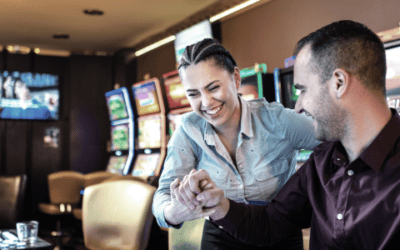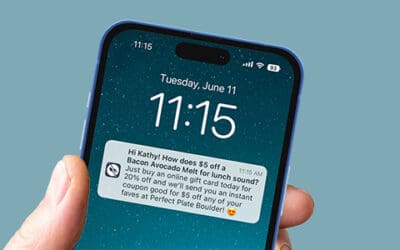

How Proximity Engagement Can Boost Customer Loyalty
It comes as no surprise that the global pandemic has delivered a tremendous blow to the spa and beauty industry. Spa visits and revenues were deeply impacted as a result of forced shutdowns and the need to limit occupancy when businesses started to reopen. In fact, according to initial findings from ISPA Foundation’s 2021 U.S. Spa Industry Study, spa revenues fell more than 36% from 2019 to 2020, and spa visits were down 35%.
But, it’s not all doom and gloom. The report, led by PricewaterhouseCoopers (PwC), also found spa revenue per visit held steady, which is promising. And the spa industry isn’t anything if not resilient. Many predict it will rebound to pre-pandemic levels within the next year or so. For now, as the world begins to reopen and spa owners and skin care professionals try to rebuild the business, the focus should be on retention and loyalty.
But loyalty, even pre-pandemic, was increasingly hard to achieve in this highly commoditized and competitive world. How do you build loyalty, deepen retention, and strengthen relationships with existing customers? One strategy is by leveraging proximity engagement marketing.
What is Proximity Engagement?
Not to be confused with mobile marketing or even location-based marketing, proximity engagement is a more precise and personalized form of communication with specific customers. Where location-based marketing typically only uses location information to send the same message to any customer in the area, proximity engagement combines geographic location with other known data about the customer to engage them with timely and relevant messages or offers that are more individually personalized.
At its core, proximity engagement is about using data to understand the specific preferences of each customer to deliver a message the customer actually wants in the moment it is most relevant, not simply sending a broadcast message you want them to receive.
That data might include recent purchase information from your point-of-sale (POS) system, booking and service history from your loyalty program or customer relationship management (CRM) platform, along with opt-in location and behavioral data from their mobile device. All of this combined creates a detailed picture of each customer’s habits and preferences, and becomes a powerful marketing tool.
Proximity engagement allows for real-time marketing that matches the customer’s immediate and personal needs. This enables brands and business owners to send more meaningful messages that make the customer feel understood and valued, which goes a long way to deepen relationships and loyalty.
In a time when competition is high and attention and loyalty are fleeting, proximity engagement is a powerful tool in creating an unforgettable customer experience.
3 Keys to Proximity Engagement
Proximity engagement is built on the principles of human behavior design developed at the Behavior Design Lab at Stanford University. Simply put, it takes motivation, ability and a prompt to converge at the same time for a behavior to happen.
Applying these three elements to proximity engagement will go a long way to increase customer loyalty and drive business. For example, when a client is nearby, their ability to come to your spa is high. If it’s been a few weeks since they’ve been in for a routine or favorite service, their motivation to act is also likely high. And when both of those criteria are aligned, the probability they will take action on a personalized prompt is high. Juxtapose that scenario with a mass SMS message that doesn’t take into consideration any of those other data points, and you can begin to see how much more effective proximity engagement can be.
When other data like the client’s service or purchase history can also be woven in, it becomes even more effective. The trick is, all of this data has to come together and be acted on in real time—and on a larger scale, since it’s really only applicable to that one customer. This is where technology comes in.
Previously, this type of personalized marketing was hard to achieve on a mass scale, unless you had a massive marketing budget. With how much technology has advanced, however, there are digital tools that are accessible for spas of all sizes to more effectively reach their customers.
The reason proximity engagement is so effective is because it can deliver well-timed, highly personalized messages—messages that encourage customers to do something they already want or need to do. It’s not about manipulating them. It’s about delivering value and high-delight experiences. That’s what builds customer loyalty and creates advocates for your services. You already know that’s one of the best ways to build your business.
Creating an Amazing Customer Experience
Every business, regardless of the product or service it provides, is in the customer service business. Consistently providing a great customer experience is what builds loyalty and turns customers into advocates.
Over the years, the bar for what stands out as a great customer experience has steadily risen. It’s not something to take for granted—businesses have to continually think about how they can surprise and delight customers. One spa, Ella Bliss Beauty Bar in Denver, Colorado, is using proximity engagement to do just that.

“One way we’re using proximity engagement is, once a customer steps into the spa, they’re greeted with a highly personalized mobile message welcoming them in,” says Kelly Huelsing, co-owner and founder of Ella Bliss Beauty Bar. “This seemingly small touch-point adds to the experience and sets the tone right when they cross the threshold.”
Huelsing says they’re also using it in unexpected ways to stay top of mind with customers by providing them relevant and timely communications when they’re in unexpected places.
“We’ve been using proximity engagement to send personalized messages to customers who, once they get to Denver International Airport, receive a massage special. They’ll receive a note along the lines of, ‘Travel is stressful. Come in when you get home and receive your favorite upgrade on a massage for free.’ It’s personalized to that specific customer, and it’s very unexpected to get the message at the airport. We’ve had a lot of success and received a lot of positive feedback on that one,” she says.
Proximity Engagement to Boost Business
Proximity engagement, when done right, can reduce customer turnover, deepen loyalty and advocacy, and generate more traffic during slow times. Particularly as many businesses continue to recover from the effects of the pandemic, proximity engagement can provide a way to re-engage customers who haven’t visited in a while.
By looking at purchase or service history, you can send customers offers inviting them in for what you know they enjoy and also let them know what health and safety measures you are taking to help them feel comfortable. To help fill last-minute cancellations or whitespace on the schedule, you can also engage those who are within a specific proximity to let them know of the openings.
“When we have whitespace on our schedule that’s within a day or two, we will use our proximity engagement tool to automatically send push notifications to clients who have had those or similar appointments in the past, or who haven’t been in within a certain amount of time, letting them know of what availability we have,” says Huelsing.
This has proven useful for each of their three locations, as they’re able to engage those who are within a specific radius of each of the spas. The motivation will naturally be higher for those who are within close proximity, so it allows Ella Bliss to target only those individuals who are most likely to take action.
“Having that flexibility with our proximity engagement tool has been really useful,” she says. “And more on the longer-term side of things, it has also had a positive impact on reducing our membership churn. Customers don’t have to be a member to come to Ella Bliss, but we have about an 80% membership base. Having those constant touch-points helps make the members feel more connected, included and remembered. It’s really had a positive impact on our membership loyalty.”
On average, Ella Bliss sees a 10% to 20% conversion rate on the notifications they send. Most of these conversions happen within four days of customers receiving the notification. For instance, they recently tested a notification that targeted customers who were in close range of the spa and who had never had a blowout treatment. That notification had a 10.5% conversion. They also send out prompts to customers 10 days after their last visit with additional service offerings and routinely see conversion rates of almost 20%.
Delivering Meaningful Value
While push notifications are a great way to increase the value delivered to clients, there’s a fine line between engaging and annoying. Unfortunately, many of the mobile marketing tactics in use today still rely on ‘batch and blast’ tactics with generalized messages to everyone in the database. Or they’ll send a generic push alert every time a customer is nearby, without taking into account that customer’s history and preferences, time of day, or other data that could be used to personalize the message.
Though brands know their customers don’t want to be shouted at or nudged, they’re still using these tactics without realizing how much it creates notification fatigue, and potentially pushes customers away. With push notifications that follow the principles of proximity engagement, however, customers feel valued and special.
You’ve no doubt heard of the many efforts underway to restrict the third-party use of customer data, which is certainly beneficial from a consumer protection and privacy perspective. By definition, however, proximity engagement is based on each customer explicitly opting in to share that data with one brand at a time, usually through their mobile app.
That’s the beauty of proximity engagement—when each customer gives permission to communicate with them based on data about their interactions with that business, and when that data is used correctly, the content and offers that customer receives are much more likely to resonate and deliver consistent value.
Focus on leveraging the data respectfully and in ways that consistently deliver value to each customer, and customers will remain engaged. The end result will be stronger loyalty, a higher lifetime value, and ultimately, increased growth.
“As we look at expanding our locations, proximity engagement will be an important part of our growth strategy,” says Huelsing.
This content was originally posted as an article in Skin Inc., October 2021 edition.
You may also be interested in
How the Right AI Can Expand the Casino Player Experience
Most casinos aren’t fully embracing AI, and, in turn, they’re missing opportunities to take care of their existing players and outpace their competition. Unrealized potential awaits—from enjoying the benefits of a true attribution channel to delighting players with...
How AI Automation Will Drive Mobile App Marketing Success
As much as we may hate to admit it, our smartphones and the apps on them have become an essential part of our lives. We use them for everything. They help us order food, shop, bank, and be entertained. Consider this fact: Last year, the number of holiday purchases...
Drive Business Growth Through the Power of Push Notifications
Have you ever received a push notification on your phone that grabbed your attention? Perhaps it was a discount code from your favorite store or an alert about an event you were keen on attending. The key factor that made it stand out among the clutter on your lock...
Overcommunicating with Your Customers Is Worse than Not Communicating at All
It recently hit me that I’ve been getting tons of emails and push notifications from brands. I started monitoring it. When I realized how bad some of the communication was, I got frustrated and started unsubscribing. And that’s what brought me here: overcommunicating...




